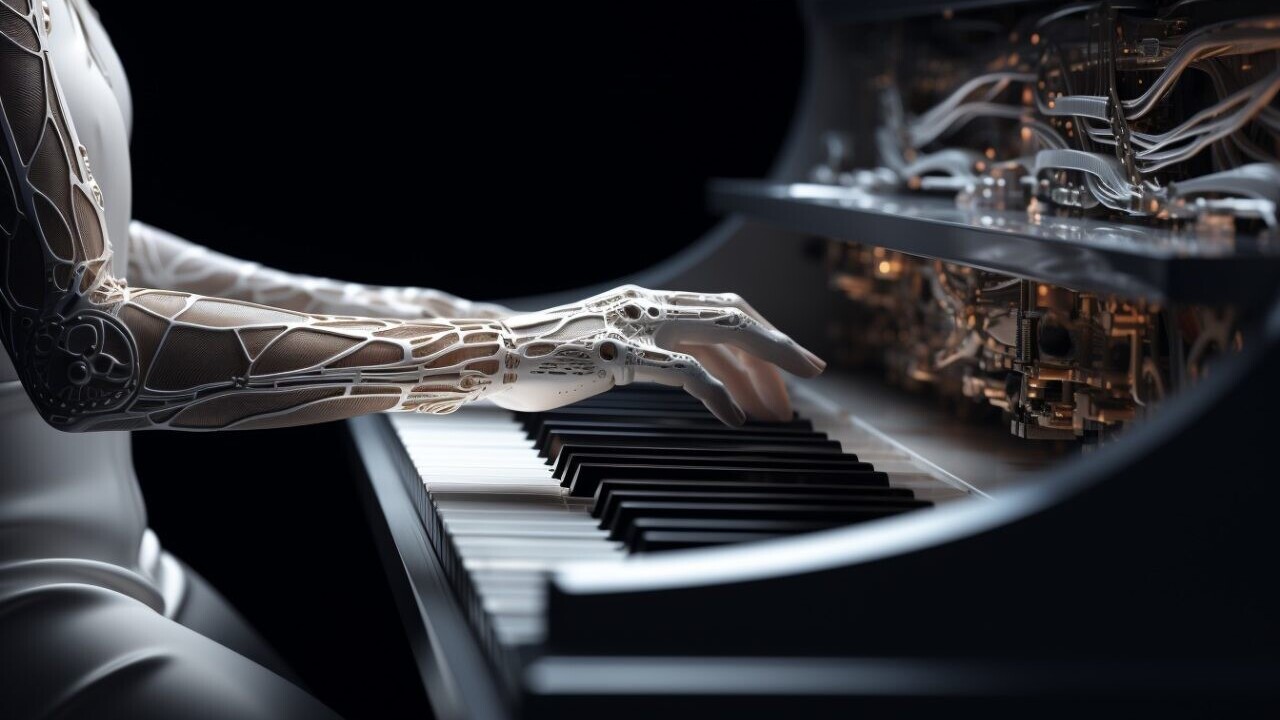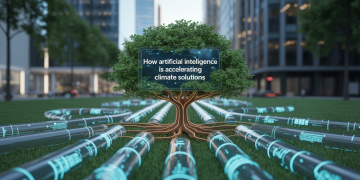The relationship between human creativity and artificial intelligence (AI) is a topic that is increasingly gaining traction in both academic and popular circles. The question—”Is AI the missing link in human creativity?”—invites us to explore the intersection between machine learning, artistic expression, and the endless potential for innovation. Can AI act as a catalyst for the kind of imaginative leaps that have historically defined human progress? Or does it serve as a tool that merely mimics creativity, never truly participating in the intuitive, emotion-driven process of human invention?
In this article, we will explore how AI is transforming the landscape of creativity across various domains, examining whether it is a tool that enhances our capabilities or an autonomous force in its own right. To do so, we’ll break down the relationship between human creativity and AI into several key areas: art, music, literature, design, and technology, offering both a historical perspective and a glimpse into future possibilities.
Human Creativity: A Brief Overview
Before diving into how AI intersects with creativity, let’s first reflect on what human creativity actually is. It’s often viewed as the ability to transcend conventional ideas and think in novel ways. Creativity involves making new connections, imagining possibilities, and expressing those ideas in unique forms—whether that’s through painting, storytelling, or invention.
At its core, creativity has always been tied to the human experience. It is driven by emotions, personal experiences, cultural influences, and a deep sense of curiosity about the world. The challenge, then, is whether AI can replicate or even amplify these inherently human qualities. Can a machine, devoid of emotion and experience, create something that resonates with human depth?
The Rise of AI in Creative Fields
AI has made remarkable strides over the past few years, not just in technical fields but in creative domains as well. One of the earliest examples of AI’s potential in creativity is in the realm of art. In 2018, a portrait created by an AI algorithm called “Edmond de Belamy” was auctioned at Christie’s for over $432,000. This was a landmark moment, showing the world that AI can not only produce visual art but also generate pieces that can be valued in the traditional art world. Since then, numerous AI-generated artworks have sparked debates about originality, authorship, and the definition of art itself.
But this is just one aspect of the AI-creativity nexus. AI’s ability to create in the fields of music, writing, and design is equally impressive. Let’s explore each of these domains.

AI in Visual Arts
AI-driven algorithms like DeepDream, GANs (Generative Adversarial Networks), and neural networks have allowed machines to produce visually stunning pieces of artwork. These algorithms analyze massive datasets of art and learn the underlying patterns, styles, and techniques. By manipulating pixels, color palettes, and brushstrokes, AI can generate images that mimic the styles of famous artists or create entirely new visual forms.
However, the question remains: can AI truly be considered “creative” in the same way that a human artist is? AI doesn’t have the lived experience, the personal emotions, or the psychological depth that inspire human creativity. While an AI can learn from human-created art and synthesize new compositions, it does so through mathematical principles, not emotional intuition. This doesn’t necessarily negate the value of AI-generated art, but it raises important questions about the nature of creativity and originality.
Still, AI is offering a new avenue for artists to explore. Human artists are increasingly using AI as a tool to augment their own creativity. Some combine AI’s generative abilities with their own ideas, creating hybrid works that blend the unpredictable nature of machines with the deliberate, expressive decisions of a human mind.
AI in Music Composition
AI has also made significant contributions to the world of music composition. Algorithms such as OpenAI’s MuseNet and Google’s Magenta have demonstrated the ability to compose complex musical pieces in a variety of genres, from classical to jazz to pop. These systems analyze thousands of musical compositions and learn to predict what note or chord might come next based on patterns and probabilities.
While some critics argue that AI-generated music lacks the soul and emotion found in human-created compositions, others argue that AI is opening up new possibilities for composers. AI can act as a kind of collaborative partner—generating musical ideas, melodies, and harmonies that human composers can then refine and transform. This blending of machine and human creativity has led to the creation of entirely new musical styles and soundscapes.
AI in Literature and Writing
In the world of literature, AI has begun to play a more prominent role as well. AI writing assistants, like OpenAI’s GPT-3, are capable of generating coherent, engaging stories, essays, and articles. These systems are trained on vast datasets of existing text, enabling them to produce writing that mimics human-style and tone.
In creative writing, AI can generate everything from short stories to poetry. But the question arises: can a machine truly understand the human experience in the same way that a writer does? The beauty of human-written literature often lies in its depth of feeling, the nuances of character development, and the exploration of the human condition. AI, as sophisticated as it is, does not “experience” the world in this way. Instead, it predicts patterns and generates text that is statistically likely to resonate with readers.
Despite this, AI-generated literature can serve as an invaluable tool for writers. Many authors use AI as an idea generator or as a means of overcoming writer’s block. By suggesting plot twists, dialogue, or even entire narratives, AI helps writers push beyond their creative limits.
AI in Design and Architecture
AI’s potential in design is one of the most exciting frontiers. Architects, graphic designers, and industrial designers are increasingly using AI-powered software to create new structures, products, and interfaces. These tools allow for the rapid prototyping of designs, optimizing aesthetic appeal while considering functionality, materials, and environmental impact.

For instance, AI has been used to generate building designs that are not only beautiful but also energy-efficient and environmentally sustainable. One example is the AI-driven design of the Tesla Gigafactory, which optimizes the factory layout to reduce production time and costs. In the world of fashion, AI can predict trends, suggest new designs, and even create entirely new clothing patterns, allowing designers to stay ahead of consumer demand.
AI’s ability to generate options rapidly and refine designs based on user input is revolutionizing the design process. However, like in other creative fields, the question persists: is AI truly “creative,” or is it simply optimizing human-driven processes?
The Role of AI as a Collaborative Tool
The clearest consensus emerging from the AI-creativity discussion is that AI is not replacing human creativity but rather enhancing it. While AI can generate art, music, literature, and design, it lacks the emotional depth, personal experience, and intuition that humans bring to the creative process. However, by functioning as a collaborative tool, AI can inspire new ideas, help break creative blocks, and allow for experimentation at a pace previously unimaginable.
Some creators are even using AI as a muse—exploring the unexpected and often chaotic outcomes generated by the machine. In this sense, AI is not just a tool but a partner in creativity, offering new perspectives and sparking innovation that may not have been possible otherwise.
The Future of AI and Creativity
As AI continues to evolve, so too will its impact on the creative world. Future developments may lead to AI systems that are more capable of understanding human emotion, context, and intuition, potentially bridging the gap between human and machine creativity. It’s not hard to imagine a future where AI and humans collaborate seamlessly to create in ways that are currently beyond our comprehension.
Moreover, as AI becomes more integrated into creative industries, we may witness an entire redefinition of what it means to be an artist, musician, or writer. Could it be that AI itself might one day be considered a “creator,” deserving of recognition for its work? These questions will likely become more pressing as AI’s role in the arts becomes increasingly prominent.
Conclusion: Is AI the Missing Link?
In answer to the question, “Is AI the missing link in human creativity?”—the answer is, perhaps, not straightforward. AI is certainly not a replacement for human creativity. It does not possess the emotional complexity or lived experiences that inform human artistic expression. However, it is undoubtedly a powerful tool that has the potential to enhance and amplify human creativity in ways that were once unthinkable. In this sense, AI may very well be the missing link between the limits of our imagination and the boundless potential of our creative endeavors.
AI is a collaborator, a catalyst for new ideas, and a partner in the ongoing exploration of human expression. As such, it is not the end of creativity but a new beginning—a bridge between the known and the unknown, where the human mind and the power of machines come together to create the unimaginable.












































